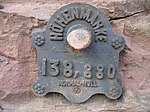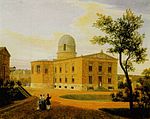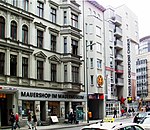The Berlin Observatory (Berliner Sternwarte) is a German astronomical institution with a series of observatories and related organizations in and around the city of Berlin in Germany, starting from the 18th century. It has its origins in 1700 when Gottfried Leibniz initiated the "Brandenburg Society of Science″ (Sozietät der Wissenschaften) which would later (1744) become the Prussian Academy of Sciences (Preußische Akademie der Wissenschaften). The Society had no observatory but nevertheless an astronomer, Gottfried Kirch, who observed from a private observatory in Berlin. A first small observatory was furnished in 1711, financing itself by calendrical computations.
In 1825 Johann Franz Encke was appointed director by King Frederick William III of Prussia. With the support of Alexander von Humboldt, Encke got the King to agree to the financing of a true observatory, but one condition was that the observatory be made accessible to the public two nights per week. The building was designed by the well-known architect Karl Friedrich Schinkel, and began operating in 1835. It now bears the IAU observatory code 548.
Although the original observatory was built in the outskirts of the city, over the course of time the city expanded such that after two centuries the observatory was in the middle of other settlements which made making observations very difficult and a proposal to move the observatory was made. The observatory was moved to Potsdam-Babelsberg in 1913 (IAU observatory code 536). Since 1992 it is managed by the Leibniz Institute for Astrophysics Potsdam (AIP), although it has not been used for German astronomical observations since the 20th century.
In Berlin remain the Wilhelm Foerster Observatory (IAU code 544), the Archenhold Sternwarte, Berlin-Treptow (Archenhold Observatory; IAU code 604), the Urania Sternwarte (Urania Observatory, IAU code 537), and the Bruno H. Bürgel Observatory.












